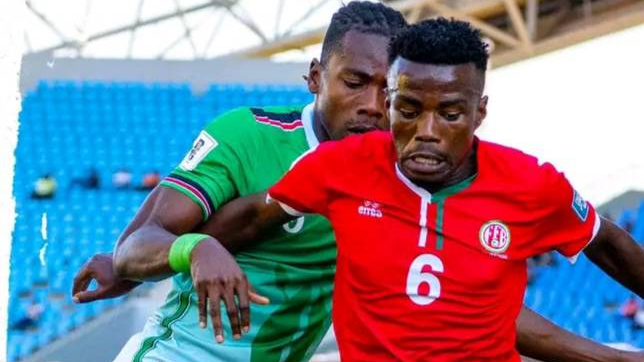The Harambee Stars faced off against Burundi in a Group F, 2026 World Cup qualifier match at Bingu National Stadium in Lilongwe, Malawi. With both teams tied at three points each, the match was a crucial opportunity for either side to gain an edge in the standings. Leaders Ivory Coast and Gabon sat at six points apiece before Friday’s matches. In this piece, we examine the tactical aspects of the game, which ended in a 1-1 draw, a result that felt like a victory for the Burundians.Coach Engin Firat deployed his team in a nominal 4-4-2 formation, a structure maintained out of possession. ##NAJAVA_MECA_8150557##Kenya Police goalkeeper Patrick Matasi was in goal, with a makeshift backline due to the absence of consistent starters Erick Ouma and Joseph Okumu. Rooney Onyango, typically a right-winger on the national team, slotted in at right-back, where he plays at club level. Johnstone Omurwa and Daniel Anyembe, usually the preferred right-back, played as the centre-back pairing, with Aboud Omar at the left-back.The midfield consisted of mainstays Richard Odada and Anthony Akumu in a double pivot. AFC Leopards captain and lead assister Clifton Miheso, a late call-up, played on the left wing, while Timothy Ouma was on the right. The forward duo consisted of Kenneth Muguna and captain Michael Olunga.Defensive StrategyOut of possession, Kenya operated in a compact 4-4-2 mid-block, aiming to prevent exposure from Burundi’s combinations between the lines. The backline dropped in unison to counter the Burundians’ attempts to create chances with balls played in behind. Burundi’s wildcard, Saido Ntibazonkiza, started as the striker, supported by attacking midfielders Abedi Bigirimana and Ellie Mukono.Burundi set up in a 1-2-3-2-3 formation during their build-up phase, with fullbacks positioned narrowly next to the deep-lying midfielder to draw the Kenyan wingers inside and create wide play opportunities. To counter this, Kenya shifted to a 4-4-1-1 in the first half, with the striker pressing one Burundian centre-back and the second striker shadowing their deep-lying playmaker. This allowed Burundi to play wide but prevented them from creating substantial threats.F.T🇰🇪 1-1 🇧🇮It ends even. Focus shifts to our next match against the champions of Africa. #Tunaweza pic.twitter.com/yG63I7cB0m— Harambee Stars (@Harambee__Stars) June 7, 2024 Offensive StrategyIn possession in the first half, Kenya played in a 1-2-1-3-3-1 formation, something not too dissimilar to what Kenya Police do in the build-up. Both centre-backs split off the goalkeeper, with one midfielder dropping deep to aid with the fullbacks rather high. Having the full-backs high allowed them to push the Burundian wingers back, allowing Kenya to have a 3v1 numerical superiority against the Burundians, who set up in a 1-4-1-4-1 out-of-possession block.This build-up structure looked to work well, with goalkeeper Matasi being able to access Aboud with perfect chipped passes. The main issue for the Kenyan side was, however, the progression phase and creation in the final third. The seen modes of starting attacks were to play a ball in behind for Olunga to chase in the channel or the left side rotations, again very evident at Police with Aboud pushing very high with the winger drifting inside, Kenya would then look to switch the ball to Aboud. The above, however, never really worked, with the best chances coming off set pieces and speculative efforts. Seeing the half end 0-0Engin Firat criticizes officiating in Harambee Stars’ draw against BurundiSecond Half and Tactical ChangesThe second half saw Kenya come on, looking to have a stranglehold on the match. Burundi was dropping deeper and deeper and allowing Kenya more time on the ball in the opponent’s half, looking to hit on the counter, with one chance going begging off the post as Saido dropped between the lines and played in his winger, who managed to sneak in ahead of Aboud. With Matasi beat, the Burundi winger saw his effort come off the post.Kenya’s chance to create came with a ball into the silent Ouma in the box; this allowed him to create separation in the box and chip a beauty to pull an acrobatic save off the Burundian goalkeeper.Coach Firat rang the changes, subbing off both wingers and bringing on Duke Abuya and Austin Odhiambo, both attacking midfielders, to play on the wings. This was in tandem with his idea of having the wingers come inside and operate in the half-space, with the full-backs now fully given the chance to bombard the opponent. This tactical switch saw a pegged back, and on the ropes, Burundi conceded. NSL: Eyes on Mara Sugar as they seek automatic promotion todayIt was a vintage Austin play; the league icon received the ball on the left-hand side, turned and picked a scrumptious penetration pass into Abuya, who, with immaculate movement, slotted home. The number of times Austin has done the above at club level is astounding.Burundi now seemed to snap back into reality; they rang the changes, taking off Saido for an out-and-out striker, a bully. They then switched to a 1-3-4-3 formation, with the defensive midfielder dropping between the centre-backs to be able to pick passes under minimal pressure.This change, with Kenya dropping deeper and deeper, saw a ball in behind, leading to miscommunication in the backline and a goal slotted in.Player ratings: Friday to forget for Matasi, Olunga as Harambee Stars draw with BurundiThe final whistle sparked celebrations from the Burundians, while Kenya felt the sting of letting victory slip away. With no time to dwell on the draw, Kenya now focuses on their next challenge against giants Ivory Coast.

